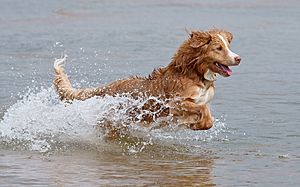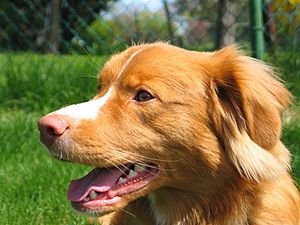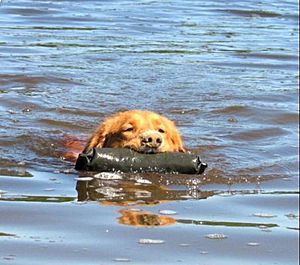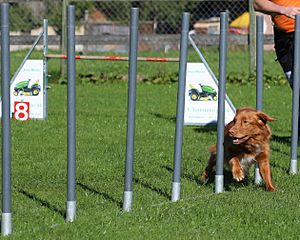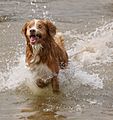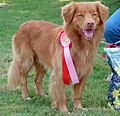Nova Scotia Duck Tolling Retriever facts for kids

An example of an adult female toller
|
|||||||||||||||||||||||||||||||||
| Other names | Yarmouth Toller, Tolling Retriever, Little Red Duck Dog, Little River Duck Dog | ||||||||||||||||||||||||||||||||
|---|---|---|---|---|---|---|---|---|---|---|---|---|---|---|---|---|---|---|---|---|---|---|---|---|---|---|---|---|---|---|---|---|---|
| Common nicknames | Toller, Duck Toller | ||||||||||||||||||||||||||||||||
| Origin | Canada (Nova Scotia) | ||||||||||||||||||||||||||||||||
|
|||||||||||||||||||||||||||||||||
|
|||||||||||||||||||||||||||||||||
| Notes | Provincial dog of Nova Scotia | ||||||||||||||||||||||||||||||||
| Domestic dog (Canis lupus familiaris) | |||||||||||||||||||||||||||||||||
The Nova Scotia Duck-Tolling Retriever is a breed of sport and hunting dog that originated in Canada in the 19th century to help hunters with attracting ducks within gunshot range and bringing the duck back to the hunter. They stand 17-21 inches (43 to 53 cm) and weigh 43 to 51 pounds (19 to 23 kg). They are the smallest of the retrievers. Its thick coat of fur protects it from the icy cold water.
Contents
History
The breed was developed in the community of Little River Harbour in Yarmouth County, Nova Scotia, around the beginning of the 19th century. The toller was originally referred to as the Little River Duck Dog before being officially recognized by the Canadian Kennel Club in 1945 as a pure bred dog. The toller is a mixture of retrievers, spaniels, setters, and possibly a farm collie mix breed, although this has yet to be confirmed. The breed was perfected in the second half of the 19th century.
The breed gained national recognition in 1980, and was declared the provincial dog of Nova Scotia in 1995, when two Nova Scotia Duck Tolling Retrievers were awarded Best in Show at championship events that included many breeds.
Use in hunting
Tollers are named for their ability to entice or lure waterfowl within gunshot range, called "tolling". The hunter stays hidden in a blind and sends the dog out to romp and play near the water, usually by tossing a ball or stick to be retrieved. The dog's appearance is similar to that of a fox. Its unusual activity and white markings pique the curiosity of ducks and geese which swim over to investigate.
When the birds are close, the hunter calls the dog back to the blind then rises putting the birds to flight allowing the hunter a shot. The Toller then retrieves any downed birds. They are particularly suited for retrieving in cold water climates because of their water-repellent double coat.
Description
Appearance
Tollers are often mistaken for small Golden Retrievers, but the Toller is more active, both physically and mentally. According to the breed standards, the Toller is athletic, muscular, compact, medium to heavy boned, balanced and powerful. The chest is deep. Conformation judges require Tollers to be capable of tolling and physical faults that inhibit working ability are heavily penalized. They should be of moderate build — a lack of substance or a heavy build are penalized by judges because both detract from the breed standard and athleticism. The legs are sturdy and solid and they have webbed feet.
Tollers can be any shade of red ranging from a golden red through dark coppery red with lighter featherings on the underside of the tail, pantaloons, and body. The lighter shades of golden red are deeply pigmented and rich in colour. The Toller should not be buff, brown, or beige, though some buff and sable Tollers do appear in breeding lines.
It is common for a Toller to have at least one of the following white markings: tip of tail, feet (not extending above the pasterns) and chest. Lack of white is not a fault; Tollers can be born without white markings. Dogs with white on the shoulders, around ears, back of neck, across back or flanks, or with silvery, grey or black areas in coat are disqualified from conformation shows.
The Toller was bred to retrieve from icy waters and must have a water-repellent double coat of medium length and softness and a soft dense undercoat. The coat may have a slight wave on the back but is otherwise straight. Some winter coats may form a long loose curl at the throat. Featherings are soft and moderate in length, the tail is well feathered and held jauntily when the dog is excited or moving.. The hair on the muzzle is short and fine. Seasonal shedding is to be expected.
Those who breed Tollers for conformation shows consider the head (clean cut, slightly wedge-shaped) to be an important feature and believe it should resemble that of a fox and must never be blocky like that of a Golden Retriever. The ears are triangular and set high and well back from the skull. The pigment on a toller's nose, lips and eye rims should match, and should be either black (which normally fades with age) or liver, blending into the coat. Lips fit fairly tightly around the mouth. The correct bite is a scissor bite, full dentition is required. Jaws are strong enough to carry a large bird, but Tollers must have a soft mouth too. Eyes are set well apart, almond shaped, and medium-sized and amber to dark brown in colour. Expression is friendly, alert, and intelligent.
Size and proportions
Tollers are the smallest of all the retriever breeds. They range in height from 17–21 in (43–53 cm) at the withers, and weigh 30–50 lb (14–23 kg), with females being slightly shorter and lighter. Tollers are a medium-sized breed.
Temperament
Nova Scotia Duck Tolling Retrievers are known to be very intelligent, curious, alert, outgoing, and high-energy dogs. They are affectionate, eager to please, busy, and get along well with children. They are good family dogs, however during the decision process potential owners should be wary of the physical and mental commitment that is required in order to keep a Toller busy. Physical stimulation should be provided for these dogs each day since they may become destructive when they are not exercised enough or are left alone for long periods of time.
Duck Tollers are working animals and are happiest when they have a job to do. Tollers are excellent hunting companions. They excel at many types of sporting competitions such as agility, dock diving, and obedience. Their keen sense of smell, intelligence, drive for work, and small size make them perfect search and rescue dogs. The breed standard states that the dog should have a strong retrieving drive, intense birdiness, endurance, and a love for water.
Tollers do not have an aggressive bark. Some have a unique sounding bark known as the "Toller scream", a high-pitched howl-like sound which is often referred to as their "singing". They do not use this in violent situations, rather; the "toller scream" is expressed when they are excited.
Socialization
Tollers have the capacity to be very social dogs as long as they are sufficiently socialized early on in life. While Tollers are energetic and outgoing around their owners and family, their cautious nature makes them reserved around strangers. Exposure to new people, locations, smells, and sights are crucial to the healthy development of the Toller breed. They tend to get along well with other dogs, however, they have a strong prey drive and may chase after cats or other small animals. Their prey drive can be avoided if cats, for example, are introduced early on in a Toller's life. Failure to properly socialize Tollers at a young age may result in aggressive, destructive, or timid behaviour in maturity.
Activities
The Toller is known to excel in various sporting and obedience activities, and health and safety related jobs. The breeds' high energy and intelligence makes them perfect candidates for difficult jobs that require tremendous dedication and skill. Tollers enjoy working and being outside, therefore, it is no surprise that they excel at various sport and job related activities.
Kennel clubs throughout the world recognize Tollers as an athletic, intelligent, and a driven breed that has the innate ability to excel in any of the following activities: dog agility, dock jumping, disc catching, flyball, lure coursing, obedience, search and rescue, therapy dog, and hunting.
Gallery
See also
 In Spanish: Retriever de Nueva Escocia para niños
In Spanish: Retriever de Nueva Escocia para niños


